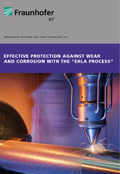Laser Material Deposition can apply high-quality coatings to components using a variety of different materials. However, this process is too slow for large components, which is why it has so far been used only sporadically for corrosion and wear protection. A further drawback of the process is that it requires high heat input into the component: the surface is locally melted, while a nozzle directs the powdery additive into the weld pool.
With EHLA, the laser melts the powder particles while they are still above the weld pool. Since this means drops of liquid material fall into the weld pool instead of solid powder particles, the layer is cleaner and smoother – roughness was reduced to just one-tenth of what it was previously. A significant advantage lies in the low heat input. While the heat of conventional Laser Material Deposition affects a zone measured by the millimeter, EHLA’s thermal effect on the material is merely in the micrometer range. EHLA thus makes it possible to coat heat-sensitive components, which had been impossible up to now because of the resulting unwanted brittle phases. This process can also be used for entirely new material combinations, such as coatings on alloys that contain aluminum or cast iron.
Laser Material Deposition achieves feed rates of between 0.5 and 2 meters per minute; in contrast, EHLA reaches between 50 and 500 meters per minute – which is 100 to 250 times faster than before. It also solves the problem of layer thickness. Until recently, layers typically had to be 500 to 1000 micrometers thick. The new EHLA process allows for layers that measure just 25 to 250 micrometers.

 Fraunhofer Institute for Laser Technology ILT
Fraunhofer Institute for Laser Technology ILT